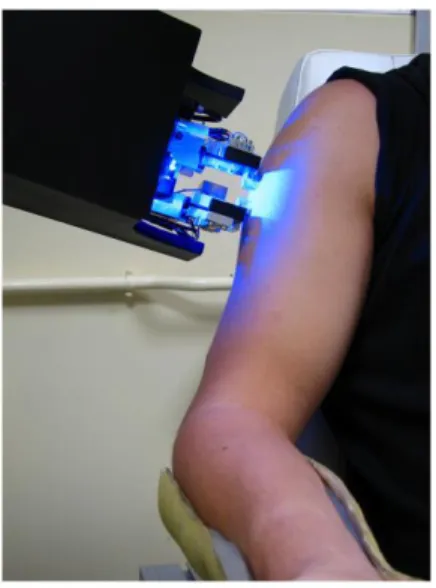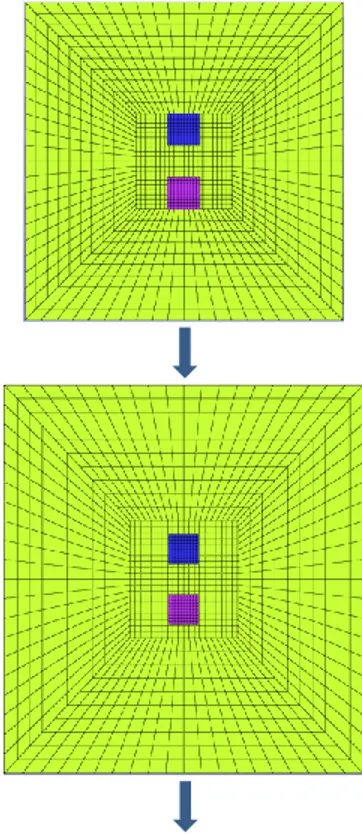HAL Id: hal-01406391
https://hal.archives-ouvertes.fr/hal-01406391
Submitted on 1 Dec 2016
HAL is a multi-disciplinary open access
archive for the deposit and dissemination of
sci-entific research documents, whether they are
pub-lished or not. The documents may come from
teaching and research institutions in France or
abroad, or from public or private research centers.
L’archive ouverte pluridisciplinaire HAL, est
destinée au dépôt et à la diffusion de documents
scientifiques de niveau recherche, publiés ou non,
émanant des établissements d’enseignement et de
recherche français ou étrangers, des laboratoires
publics ou privés.
IDENTIFICATION OF MATERIAL PROPERTIES OF
HUMAN SKIN IN VIVO
Sam Evans, Gaetan Boyer, Jerome Molimard, Hassan Zahouani
To cite this version:
Sam Evans, Gaetan Boyer, Jerome Molimard, Hassan Zahouani. IDENTIFICATION OF MATERIAL
PROPERTIES OF HUMAN SKIN IN VIVO. 11th International Symposium on Computer Methods
in Biomechanics and Biomedical Engineering, Apr 2013, Salt Lake City, United States. �hal-01406391�
INTRODUCTION
The mechanical properties of skin are of interest for many applications, including the design of devices that interact with the skin and simulation of skin deformation for applications such as animation. There is also a need to better understand the mechanical behavior of the skin in order to be able to measure its properties, for example to evaluate the effect of medical treatments or cosmetics. The mechanical properties of the skin are parameters in a constitutive model, and without a suitable constitutive model they cannot be measured properly. For example, many studies have considered the skin to be linearly elastic and measured its Young’s modulus but this is of limited value because of its extreme nonlinearity.
The aim of this study was to use an extensive set of data obtained from tests on human subjects with multiple tests in different directions to identify anisotropic material properties. The anisotropy of the skin is complicated by the large anisotropic initial strain that it has in vivo, which has the effect of making its in situ behavior anisotropic even if its actual material properties are not. Tensile tests on ex vivo human skin [1] have shown two phases of deformation, similar to other biological membranes [2]. In the initial phase the stiffness is very low, and then when the collagen fibres in the dermis become taught the stiffness increases dramatically. It was found that the major difference between loading directions was the length of the first phase, the stiffness in the second phase was similar in all directions. There is thus close relationship between the initial strain and the anisotropic material behavior; both determine the strain that is needed to reach the stiffer second phase of deformation.
METHODS
The testing device aims at imposing a tension on a delimited surface of the skin in a chosen direction.
Fig. 1. Testing device during in vivo test on the arm.
The extensometer is composed of a static and a movable pad attached to the skin by double-faced adhesive. The choice of a static pad permits to measure the force due only to the stressed area. Indeed, the movable pad measures the force of the stressed area in addition to the force due to the surrounding area. The size of the pads can be from 10×10 up to 20×50 mm2. The gap between the pads ranges from 2 to 27 mm. Each pad is mounted force sensors (tangential and normal).
Proceedings of the 11th International Symposium, Computer Methods in Biomechanics and Biomedical Engineering
April 3 - 7, 2013, Salt Lake City, Utah, USA
IDENTIFICATION OF MATERIAL PROPERTIES OF HUMAN SKIN IN VIVO
Sam L. Evans (1,2), Gaetan Boyer (3), Jerome Molimard (2), Hassan Zahouani (4)
(1) School of Engineering Cardiff University Cardiff, Wales, UK
(2) LCG, UMR 5146, Ecole Nationale Supérieure des Mines, CIS-EMSE, CNRS, Saint-Etienne, France
(3) Laboratoire PERITESCO, 18 Avenue de l'Opéra,
75001 Paris, France
(4) Laboratory of Tribology and Systems Dynamics UMR5513
CNRS/ECL/ENISE/EMSE, 36 avenue Guy de Collongue, 69134 Ecully, France
The normal force sensors allow controlling the pressure applied by the pads on the skin. This point has been discussed by [1] and seems to be very important to improve the accuracy of the measurement. Ideally, tests should be performed with a pressure as close as possible of zero. The translation stage allows a movement with a velocity ranging from 0.1 to 1.5 mm/s with accuracy less than 1 µm. This equipment is itself mounted on a complete movable frame allowing X,Y,Z movement and rotation using a ball pivot.
Measurement of the skin deformation is performed by a dedicated Digital Image Correlation set-up made of an 8 bits camera placed over the pads and low-distortion optics (deformation less than 0.1%). Two groups of three blue (λ= 470 nm) LEDS lighten the studied area. Last, a laser projects a line on the stressed area in order to measure a profile. The field of view is 1280×960 pixels2, corresponding to an area of 20×15 mm2 (15.6 µm/pixel). During the test, images are recorded at a frequency of 10 frames/s.
The in vivo test have been performed on the forearm of 2 groups of healthy young and old women, respectively 23.2 +/- 1.6 (10 subjects) and 60.4 +/6 2.4 (group 2, 10 subjects). Only one typical result is presented here for the seek of clarity (26 years old woman). The size of the pads was 10×10 mm2, the initial gap was 10 mm and the displacement of the movable pad was an extension of 1 mm with a velocity of 1 mm/s. The reference axis ⃗⃗ is the axis of the forearm, and the angle between ⃗⃗ and the axis of the tension test ⃗ is noted . 4 different angles (0°, 45°, 90°, 135°), and 10 load step are used for each experimental test-case. Displacement fields and maximum load on static and movable pads for each direction are shown in figure 2 using 5% strain (0.5 mm of displacement on movable pad). Furthermore, we can also observe a difference of 41.6 %, 101.8 % and 86.3 % between the forces on static and movable pads respectively for 0°, 45°, 90° and 135° direction which confirm the influence of the surrounding area for the force measurement.
a)
b)
Fig. 2. Example of result obtained from DIC measurement ( =0°) a) transverse displacement b) longitudinal displacement
The tests were simulated by a finite element model, using FEBio [ref??]. The experiment was modeled in three steps as shown in Fig. 1, an initial anisotropic biaxial deformation to simulate the initial stretch in the skin, a rotation to simulate measurements in different directions relative to the principal stretches in the skin, and finally the test itself in which one jaw was fixed and the other moved. The resultant force in each jaw was then recovered for comparison with the experimental data.
The skin was initially modeled as an Ogden material with isotropic properties, using parameters identified in a previous study (=10 Pa, =26). The jaws were modeled as rigid bodies and a novel feature of FEBio was used whereby the tied contacts between the jaws and the skin could be switched on and off at different stages of the analysis, allowing different initial stretches and loading directions to be easily simulated. Various initial stretches in the range 1.2 to 1.35 were simulated in order to determine whether the apparent anisotropic behavior of the skin could be adequately simulated by an isotropic, nonlinear model with anisotropic initial stretches.
Fig. 1. Stages of the finite element simulation showing the initial stretch, the rotation of the jaws and the extension of the skin. Loading at an angle to the anisotropic initial stretch produces a complex stress distribution - the maximum principal stress is shown here.
RESULTS
Fig. 2 shows the predicted force on the moving jaw at 0.5mm displacement for various different initial stretches and loading directions.
Fig. 2. Measured and predicted forces at 0.5 mm deformation for various initial stretches. The legend shows the initial stretch in the x
(parallel to the forearm) and y directions; “Exp” indicates the experimental measurements.
DISCUSSION
Mechanical properties for skin in the literature vary enormously, but much of this variation may be due to differences in different parts of the body, in the condition of the skin and the test environment and the constitutive model that is used to describe it. However, using values derived from a previous, different experiment we were able to correctly predict the forces measured in this study. This tends to confirm that much of the variation in published properties may be due to differences in body sites and test conditions and that the properties of the skin may be more consistent than the literature would suggest.
It was also possible to reproduce much of the measured variation in stiffness by using an anisotropic initial stretch with an isotropic material model. Although we know from ex vivo tests that the skin is anisotropic, the difference in different directions is mainly in the length of the initial phase of deformation and replacing this with an anisotropic initial stretch could allow a simpler modeling approach and avoid the need to identify material property directions and anisotropic properties. However, in the experiment it was found that one direction was much stiffer and the others were all similar and this cannot be reproduced by varying the initial stretch. Changing the initial stretch produces a sinusoidal variation in properties, modified by the material nonlinearity, and it would be difficult to reproduce the measured behavior without an extreme and unrealistic nonlinear material response. Anisotropic material behavior is therefore needed to fully reproduce the observed deformation, although an isotropic material with anisotropic initial stretch offers a useful compromise between accuracy and simplicity.
Further simulations are in progress to include different deformations and multiple subjects and to make use of simultaneous digital image correlation measurements of the deformation around the loading jaws. The effects of a range of different material properties and initial stretches will be described by a statistical model which will then be used to identify the initial stretches and material parameters for a large number of subjects and to determine confidence intervals for these parameters.
ACKNOWLEDGEMENTS
The generous assistance of Steve Maas in adding the contact switching algorithm in FEBio is gratefully acknowledged.
REFERENCES
[1] Lim K. et al., New extensometer to measure in vivo uniaxial mechanical properties of human skin. Journal of Biomechanics, 2008; 41(5), p. 931-936.
[1] Groves, RB, Coulman, S, Burchill, JC and Evans, SL, An anisotropic, hyperelastic model for skin: experimental measurements, finite element modelling and identification of parameters for human and murine skin. JMBBM, in press.
[2] Persson, C, Evans, SL, Marsh, R, Summers, JL and Hall, RM, Poisson's ratio and strain rate dependency of the constitutive behavior of spinal dura mater. Ann Biomed Eng, 38(3):975-83, 2010.
0 0,02 0,04 0,06 0,08 0,1 0,12 0,14 0 45 90 135 1.2 1.2/1.3 1.3 exp 1.24/1.34


